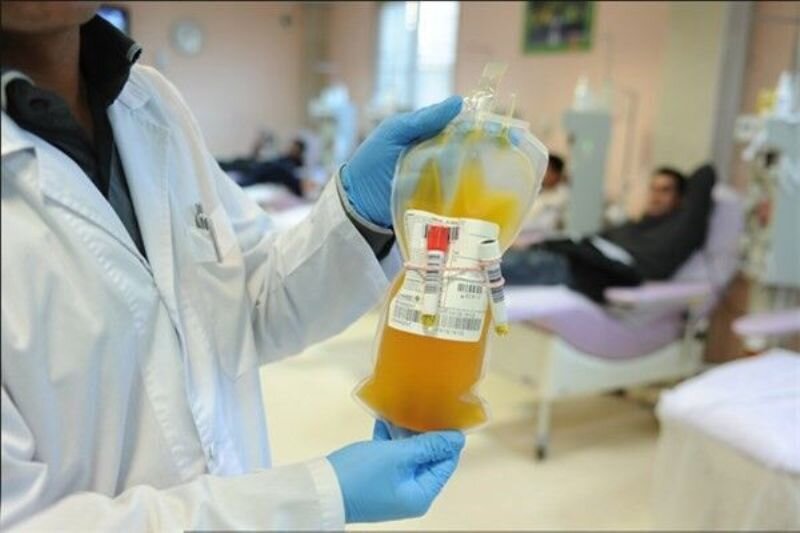Over 8,500 plasma units donated during pandemic

TEHRAN – Since the onset of the COVID-19 outbreak, 8,550 units of plasma have been donated, Bashir Haji Beigi, spokesman for the Blood Transfusion Organization has announced.
Following the outbreak of coronavirus, doctors, pharmacists, scientists, and others are looking for a way to control the virus, and so far many studies and researches have been done in this regard.
One of the studies showed that the plasma driven from recovered patients can be used in the treatment of COVID-19 with the help of the patient's immune system.
Convalescent plasma therapy allows someone who has recovered from a coronavirus infection to donate their blood plasma to someone who is critically ill.
The best time for plasma donation is at least 14 and preferably 28 days after recovery, and donors should age 18 to 60 years.
Plasma therapy has so far reduced coronavirus deaths in Iran by 40 percent as proved to be a life-saving method for those recovering from COVID-19.
The highest number of plasma donators were from the provinces of Tehran, Isfahan, Khuzestan, Khorasan Razavi, Mazandaran, and West Azarbaijan, he noted.
National blood donation campaign
Some 4,012 people referred to the blood transfusion centers and donated blood on the day of Arbaeen, which is marked to commemorate 40 days after the martyrdom of Imam Hussein (AS) in the month of Muharram.
A national blood donation campaign has been launched during the month of Muharram for forty days since Tasua (the ninth day of the month), he said.
The number of blood donors on Arbaeen has increased by 5.5 percent compared to last year, and the largest number of blood donors belonged to the provinces of Tehran, East Azarbaijan, Fars, West Azarbaijan, and Khorasan Razavi.
During the first six months of this year (March 21- September 22), 1,193,668 people referred to blood transfusion centers across the country to donate blood. During this period, 940,739 blood units were donated, he explained.
Blood donation in Iran
While blood donation in 70 countries still depends on replacement or paid donors, Iran is the first country in the region that has enjoyed voluntary blood donation by 100 percent since 2007.
More than 85 percent of all donated blood worldwide is used to produce blood products, while the rate is 65 percent in Eastern Mediterranean countries. Iran ranks among the highest-income countries in terms of converting more than 97 percent of the blood donated by people to plasma-derived medicinal products (PDMP).
Only 55 of 171 countries produce PDMP through the fractionation of plasma collected in the reporting country. A total of 90 countries reported that all PDMP are imported, 16 countries reported that no PDMP was used during the reporting period, and 10 countries did not respond to the question, according to WHO.
Iran currently has the highest blood donation rate in the Eastern Mediterranean region so that out of 9.9 million blood donation units in this region, more than two million belongs to Iran.
Also, the index of blood donation is 25 per 1,000 populations, while in the member states of the Eastern Mediterranean region, this number is 14.9 per 1000.
Blood donation saves millions of lives
According to the World Health Organization, blood transfusion saves millions of lives and improves health, but many patients requiring transfusion do not have timely access to safe blood. Providing safe and adequate blood should be an integral part of every country’s national health care policy and infrastructure.
About 117.4 million blood donations are collected worldwide. 42 percent of these are collected in high-income countries, home to 16 percent of the world’s population.
About 12,700 blood centers in 170 countries report collecting a total of 100 million donations. Collections at blood centers vary according to income group. The median annual donation per blood center is 1,300 in the low-income countries, 4,100 in lower-middle-income countries, and 8,500 in upper-middle-income countries, as compared to 23,000 in the high-income countries.
Data about the gender profile of blood donors show that globally 32 percent of blood donations are given by women, although this ranges widely. In 14 of the 119 reporting countries, less than 10 percent of donations are given by female donors.
Moreover, 62 countries collect 100 percent of their blood supply from voluntary, unpaid blood donors. Some 108 million blood donations are collected globally, half of these are in high-income countries. Meanwhile, blood donation by 1 percent of the population can meet a nation’s most basic requirements for blood.
FB/MG
